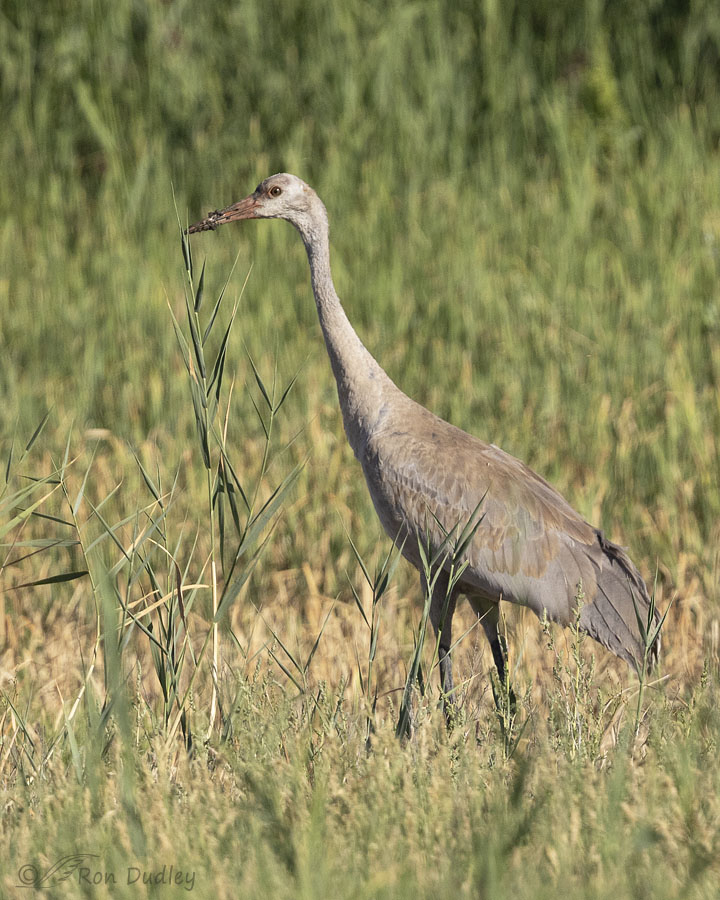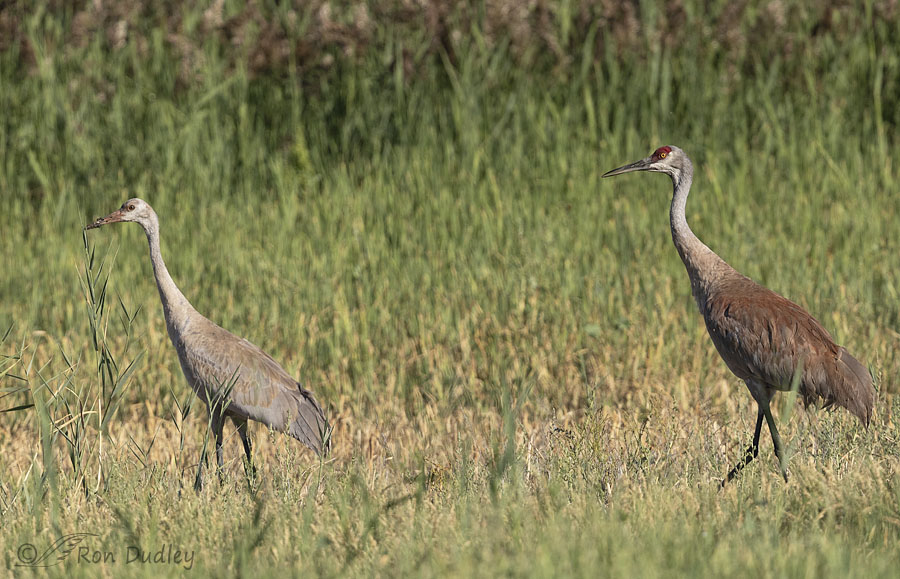Two days ago at Bear River MBR I photographed a young juvenile Sandhill Crane at a stage of development I’d never documented up close before.

I’ve seen juveniles that were younger and older but never looking quite like this, at this size and color and without the red crown of the adult. This guy has a gob of mud on ‘his’ bill.
So, how big (tall) do you think he is?

1/5000, f/6.3, ISO 800, Canon R5, Canon EF500mm f/4L IS II USM + 1.4 tc, not baited, set up or called in
He’s approaching the size of his nearly 4′ tall parent. Since he only weighed 4 ounces when he was hatched (I very strongly prefer “hatched” over “born”), that’s a lot of growth in such a short time.
He’s still the ‘natural’ grayish color of Sandhill Cranes because he hasn’t yet stained his plumage by deliberately rubbing iron-rich soil on his feathers like the adults so often do. He also doesn’t have the red crown or orange-red eye of the adult. But it won’t be long until he’s as tall as his parents and develops all of the aforementioned adult features.
He’ll stay with his parents for a total of 9-10 months, from nesting through fall migration, wintering and the first spring migration. Independence from his parents won’t occur until toward the end of his first spring migration, 30 to 60 days before his parents have their next clutch of eggs.
Since a young crane at this stage of development was new to me, I thought it might also be new to some of my readers so I decided to share.
Ron


This is wonderful! Since these birds only are in our area in the winter, after migration, I don’t think I’ve ever seen such a young one. There probably are some first-year birds in the groups I see, but given their growth rate, my inexperienced eye can’t sort them out. This year I’ll pay more attention to that feather color; I’ve noticed it in the past, but didn’t think a thing about it.
Another great post full of new info. I’ve learned to read your blog later in the day in case a reader, such as Dan Gleason, has weighed in.
On another note, how’s your amaranth doing this year? The seeds you sent me germinated well but then the bunnies had their way with the young plants. I’ve just recently started to see flower growth on the tallest ones.
Linda, my garden has gobs of amaranth in it but the ferocious hailstorm we had on June 3rd really shocked the young plants and they never fully recovered. So even though mine have been flowering for weeks they aren’t as tall as they usually are.
I do love my beautifully illustrated lessons here. Huge thanks to you and to Dan.
And wow – that is an incredible growth spurt – something not seen in our slow species until the child is a teenager.
Thanks, EC. Dan is an almost limitless source of avian knowledge.
Feather staining in Sandhill Cranes is an interesting behavior. A lot of ideas have been put forward but camouflage seems to be the most accepted thought. While incubating eggs on ground nests, it is thought that the staining helps make them less visible as they are stained with the surrounding soils. Both male and female incubate during the day so it helps both individuals. The Common Crane of Europe and Asia also does this behavior but often to a lesser extent than Sandhills. No other cranes are known to do feather-staining. Young birds also have been seen with feather-staining, likely imitating adult behavior.
Thanks for that background, Dan. I was especially interested in your last two sentences.
Once again I have learned something new about the wildlife around us. I learn things from all your posts, I would never have guessed. I believe teachers never stop trying to inform us of little things to enrich our knowledge of life around us.
Thanks, Trudy. I guess I can’t get teaching out of my blood.
Ron,
I always love your stuff!! (“Stuff” = interesting and educational information along with world class pictures. I didn’t want to be perceived as disrespectful.)
Stephen
Ha, I’m an expert at using “stuff”, Steven. Such a useful word. No chance that I’d take what you said as being disrespectful.. Thanks.
I’m speculating about the purpose of the staining of the feathers
with “iron rich soil”–maybe insect control ? I loved seeing the juvenile
beside an adult–even as a “teen”, a crane is, as Jerzy already said,
–so ELEGANT……..
Kris, I remember reading somewhere that they stain their feathers for camouflage purposes. However, I can’t confirm that it’s actually true.
A LARGE adult bird to start off so small! Huge amount of growing and learning before being on their own. The young one would still camoflage well it appears……. They are amazing birds…..
They sure are. In a lot of ways.
Thank you. Very interesting.
I do not why but for me there is something nostalgic about these elegant birds.
Thanks, Jerzy. There’s a lot of reasons to like Sandhill Cranes.
Fascinating. All new to me. Another lesson from FP.
Phenomenal growth rate!
Thank you, Michael.
Very interesting Ron. I have seen Cranes here in Prescott, but never juveniles. You mention their rapid growth here. I have always been amazed how very fast our wildlife grows as compared to how long it takes we humans to. Pronghorns trotting along with their moms just a couple days after birth. I just spent time this spring watching our two Bald Eagle chicks and then juveniles grow up into large powerful birds who 45 days after fledging are flying off north completely separated from their parents. Thanks for another educational post.
Thanks, Everett. I agree, their growth rate is amazing.